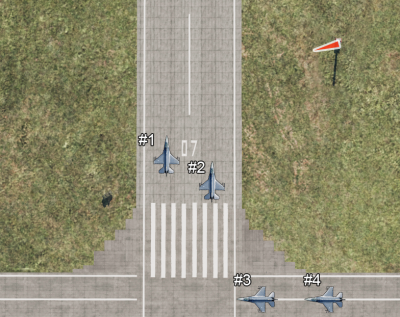Takeoff Procedures
Home >> Standard Operating Procedures >> Airport Procedures >> Takeoff Procedures
The following takeoff procedures are our standard ways of departing in a 4-ship (i.e division). As a flight lead, you may deviate from these ways and perform any kind of non-standard takeoff, if there's a good reason for it (for instance mixed flights, uneven/unusual loadouts, extreme winds, special exercises). However, in order to establish common standards, the recommendation is to use these whenever possible.
All the different procedures can also be applied to (and are recommended for) 2-ship flights (i.e sections) simply by ignoring the #3 and #4 instructions.
Standard speed after takeoff is 300 kts. For slow aircraft, like A-10C, 200 kts is recommended.
Innehåll
VFR
A. Rocket Ripple Takeoff
#1 go, 10 sec wait #2 go, 10+ sec wait #3 go, 10 sec wait #4 go
Rejoin visually in Fingertip Left
B. VFR Section Takeoff
#1 and #2 go, 10+ sec wait #3 and #4 go
Rejoin visually in Fingertip Left
IFR
C. Double Sensor Trail Takeoff
#1 go, 10 sec wait #2 go, 30+ sec wait #3 go, 10 sec wait #4 go
Use sensor to maintain 1 nm between Lead and Wingman
Use sensor to maintain 1+ nm between sections, slightly offset
Rejoin visually in Fingertip Left when on top of the weather
D. IFR Section Takeoff
#1 and #2 go, 30+ sec wait #3 and #4 go
Use sensor to maintain 1+ nm between sections, slightly offset
Rejoin visually in Fingertip Left when on top of the weather
In IFR, for aircraft not equipped with radar, split the flight into two 2-ship sections for the departure, with separate ATC clearances. Perform two completely separate Section Takeoffs. Rejoin when on top of the weather.
Detailed description
Example
This section explains how to parse the information above, using A as an example. In this variant, the lead aircraft will apply power and start to roll first. The wingman (#2) waits 10 seconds until he does the same. After another 10 seconds this procedures goes on with the two remaining aircraft (#3 and #4), each with another 10 seconds between, until everybody is rolling and take off.
Initial formation
Before taking off, line up on the runway in a staggered formation. Lead positions himself on the downwind side (if the wind is coming from the right, lead should be on the left side). The wingman should position himself in echelon formation on the other side of the runway.
Comms
If taking off from an airfield with a manned (human player) Tower, wait for a "Cleared for takeoff". In the flight, lead should make sure everyone is ready before taking off. The recommended way is to ask the wingmen to report in (in flight order) when they're ready, simply saying "1", "2", "3", "4". For non-formation takeoffs, no additional comms are necessary, but it's quite common to report "1 goes", "2 goes" and so on. If lead does it, assume he wants you to the same.
Power setting
Note that power settings are not specified in these SOP. It's up to the flight lead to decide, based on what's best for that aircraft type, the current loadout and so on. Typically, takeoffs are performed in MIL (max power without afterburner) or FULL (max power with afterburner).
Section takeoffs
During section (formation) takeoffs, lead and wingman should spool the engines up and stay still by applying wheel brakes. Lead orders brake release by calling "Breaks breaks breaks", and both aircraft should release brakes on the third "breaks" and apply takeoff power. Lead should set power to just below the advised power setting, in order to give his wingman some margin to stay in formation. The wingman should keep in echelon left/right formation during the whole takeoff.
